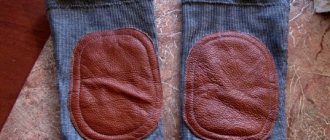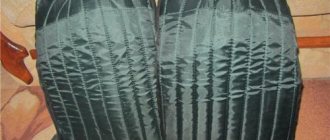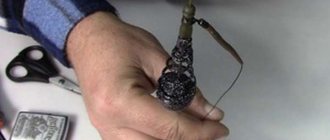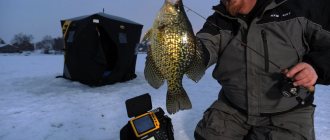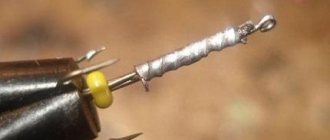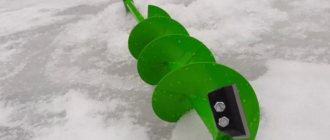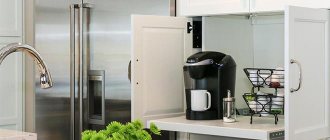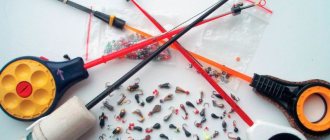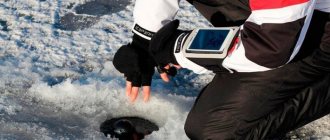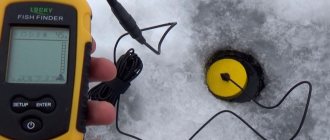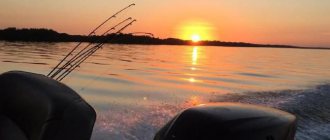Are they required? What are they needed for?
Knee pads are a device that is worn over the legs and makes kneeling more or less comfortable and protects the knees from cold and moisture .
Expert opinion
Knipovich Nikolai Mikhailovich
Zoologist, hydrobiologist. I am interested in fishing at a professional level.
Interesting! Knee pads came into amateur fishing from sport fishing, since for a sports fisherman one of the factors influencing the final result is the fishing speed. Almost all athletes use knee pads, since catching while kneeling without this piece of equipment is impractical - the knees will hurt and there is a possibility of colds in the knee joints, and catching while sitting on a chair or box is unacceptable for an athlete, since the fishing speed is much lower. It is much more convenient to catch with knee pads.
Usually, knee pads are worn when fishing with small or baitless jigs, because during such fishing it is necessary to actively play with the bait, and by kneeling, you can minimize the negative influence of the wind on the nod .
DIY knee pads for winter fishing. Making knee pads for winter fishing
For winter fishing, fishermen need additional equipment: tackle, hooks, fishing rods and special items of clothing in which a person can go hunting. Knee pads for winter fishing are a useful piece of equipment.
Today they are sold in most specialty stores. If a fisherman has a small amount of time and does not want to waste money, then it is not difficult to build a pair of comfortable winter knee pads for fishing with your own hands.
Equipment for winter fishing
Every experienced angler knows how much the process differs from what is usual at other times of the year. And it's not just about weather conditions. Fishing rods, fishing line, clothes and equipment - winter makes its own adjustments to everything. You will even need a tent in cold weather.
Advantages and disadvantages of fishing from the knees
Advantages:
- Protection from bruises and cold ice.
- The knee pads do not take up much space and fit easily into your bag.
- It's more convenient to fish. The speed and efficiency of fishing increases, as the fisherman is closer to the hole.
- The influence of wind on the nod is reduced.
- It's easier to do the wiring.
- It's easier to remove the catch from the hook. Simply lift the fish and remove it from the fishing rod.
- Feeding and cleaning the hole is simplified.
- There is no need to carry a box with you to go between holes.
Flaws:
- This type of fishing is not suitable for people with back or lower back pain, as these parts of the body will be constantly tense.
- It is necessary to take breaks and move around periodically. There is a risk of breaking your back when constantly fishing on your knees.
- If the knee pads are not thick enough, there may be a feeling of coldness in the knees. There is a risk of catching a cold in the joint.
- In the spring, when there is water on the ice, you can get your knees wet and cold.
If, after weighing all the advantages and disadvantages, the fisherman concludes that fishing from the knees is still for him, it is worth considering the possibility of creating knee pads with your own hands.
How to make knee pads for ice fishing with your own hands
Often manufacturing companies make products from non-waterproof materials. Therefore, many fishermen make their own knee pads.
Patterns
Before making knee pads for winter fishing, you should decide how much material you will need. You need to make a kind of pattern for the knee pad.
To do this, it is recommended to use a measuring tape to measure the parameters of the knee completely, then separately in width and height those areas that should be covered with knee pads.
The material will have to be folded several times, so you need to multiply the width of the knee by 3 so as not to cut off too small a piece. After measuring the parameters, you can draw a sample of the knee pad on a piece of cardboard and use the pattern as a template for cutting out the insulation.
Materials and tools
Materials you will need:
- Waterproof fabric. Suitable material from a hammock, an old tent, a raincoat or a sports jacket.
- A piece of insulation that will serve as a heat insulator.
- Wide elastic band or reinforced tape. If desired, you can replace it with electrical tape.
- Velcro.
- Foil.
Manufacturing process
Pipe insulation is often sold rolled up, so it must first be flattened. To do this, the material is spread over the entire area, a heavy object is placed on top as a press and left in this form for several days.
The insulation will level out literally within 2 days and will no longer curl. If it is not possible to store the thermal insulation material unfolded, then to straighten it you can simply twist it inside out with a tube.
Having prepared the insulation, the piece needed for the knee pad is cut out of it. This is easy to do using a pattern or by eye. Then the canvas is folded 3 times. If desired, foil is placed between the layers of insulation for thermal insulation and protection from ice. Another layer of foil is placed over the surface of the product.
The next stage is the manufacture of a case into which the workpiece is placed. It is necessary to sew the cover so that the insulation fits tightly into it. A pattern with dimensions will again help with this. However, it is worth additionally taking into account the width of the insulating material.
Having inserted the foil and insulation into the cover, stitch them from the knee side to secure the fabric. You should act carefully so as not to further damage the surface of the knee pad.
For convenience, a wide elastic band is sewn to the knee pads. It will hold the equipment tightly in place without squeezing the leg. For this purpose, electrical tape or reinforced tape is used, but a simple rubber band is most convenient to use.
If you decide to use reinforced tape, do not forget about Velcro. They need to be sewn on before the insulation is inserted. It will be difficult to do this later.
This concludes the production of knee pads. Each angler can add features to the design, improving the equipment depending on their needs.
Benefits of homemade knee pads
Homemade equipment will be the most convenient option. The product will be insulated and waterproof and will perfectly fit its owner.
Advantages and disadvantages
The use of knee pads provides the angler with the following benefits:
- The ability to fish from your knees, while the angler:
- is close to the hole and the playing process takes less time;
- the back protects the nod from the wind;
- has the ability to catch fish unnoticed by competitors;
- does not feel the need to sit, i.e. in a chair or fishing box that you have to drag around with you.
- They protect the angler's knees from cold and moisture, so you can fish even while standing on wet snow.
- They protect the fisherman from bruises if he falls with his knees on the ice.
- constant tension in the joints and back. This fishing method is not suitable for every angler. People with sore backs and joints cannot fish this way. But even those who are comfortable with fishing from their knees are forced to move from time to time to stretch their stiff knees;
- even wearing knee pads, there is a chance of catching a cold in the knee joint;
- If there is a lot of water on the ice, even waterproof knee pads will not help, which can also lead to illness.
In addition, knee pads are a fairly compact piece of equipment and you can constantly take them with you while deciding whether to use them on the spot.
But fishing on your knees, even with the use of knee pads, is associated with some disadvantages, the main of which are:
Pattern of knee pads. Making knee pads for winter fishing
For winter fishing, fishermen need additional equipment: tackle, hooks, fishing rods and special items of clothing in which a person can go hunting. Knee pads for winter fishing are a useful piece of equipment.
Today they are sold in most specialty stores. If a fisherman has a small amount of time and does not want to waste money, then it is not difficult to build a pair of comfortable winter knee pads for fishing with your own hands.
Equipment for winter fishing
Every experienced angler knows how much the process differs from what is usual at other times of the year. And it's not just about weather conditions. Fishing rods, fishing line, clothes and equipment - winter makes its own adjustments to everything. You will even need a tent in cold weather.
Advantages and disadvantages of fishing from the knees
If, after weighing all the advantages and disadvantages, the fisherman concludes that fishing from the knees is still for him, it is worth considering the possibility of creating knee pads with your own hands.
How to make knee pads for ice fishing with your own hands
Often manufacturing companies make products from non-waterproof materials. Therefore, many fishermen make their own knee pads.
Patterns
Before making knee pads for winter fishing, you should decide how much material you will need. You need to make a kind of pattern for the knee pad.
To do this, it is recommended to use a measuring tape to measure the parameters of the knee completely, then separately in width and height those areas that should be covered with knee pads.
The material will have to be folded several times, so you need to multiply the width of the knee by 3 so as not to cut off too small a piece. After measuring the parameters, you can draw a sample of the knee pad on a piece of cardboard and use the pattern as a template for cutting out the insulation.
Materials and tools
Materials you will need:
Manufacturing process
Pipe insulation is often sold rolled up, so it must first be flattened. To do this, the material is spread over the entire area, a heavy object is placed on top as a press and left in this form for several days.
The insulation will level out literally within 2 days and will no longer curl. If it is not possible to store the thermal insulation material unfolded, then to straighten it you can simply twist it inside out with a tube.
Having prepared the insulation, the piece needed for the knee pad is cut out of it. This is easy to do using a pattern or by eye. Then the canvas is folded 3 times. If desired, foil is placed between the layers of insulation for thermal insulation and protection from ice. Another layer of foil is placed over the surface of the product.
The next stage is the manufacture of a case into which the workpiece is placed. It is necessary to sew the cover so that the insulation fits tightly into it. A pattern with dimensions will again help with this. However, it is worth additionally taking into account the width of the insulating material.
Having inserted the foil and insulation into the cover, stitch them from the knee side to secure the fabric. You should act carefully so as not to further damage the surface of the knee pad.
For convenience, a wide elastic band is sewn to the knee pads. It will hold the equipment tightly in place without squeezing the leg. For this purpose, electrical tape or reinforced tape is used, but a simple rubber band is most convenient to use.
If you decide to use reinforced tape, do not forget about Velcro. They need to be sewn on before the insulation is inserted. It will be difficult to do this later.
This concludes the production of knee pads. Each angler can add features to the design, improving the equipment depending on their needs.
How to choose in a store
When choosing warm knee pads in a fishing store, the angler should keep in mind the following criteria:
- size. Knee pads need to be tried on, and the thickness of the pant leg of the winter suit must be taken into account;
- thickness of the heat-insulating layer and quality of the heat-insulating material;
- degree of water resistance of the outer layer. There is no need for a membrane here, the fabric simply should not allow water to pass through;
- convenience. This refers to how the knee brace is attached to the leg. It can be Velcro or rubber bands - the main thing is that everything works properly;
- appearance.
Pros and cons of homemade
Homemade knee pads can be completely different - it all depends on the skill of the manufacturer, design features, properties and quality of the materials used.
They have the following advantages:
- they are precisely adjusted to the angler’s foot;
- The fisherman determines all their properties initially, before starting production;
- they are much cheaper than store-bought products;
- Fishing in knee pads made with your own hands brings incomparable joy.
But homemade knee pads also have some disadvantages, namely:
- do not look as impressive as branded ones;
- their production requires serious time investment and certain qualifications.
Self-production
There are quite simple ways to make knee pads with your own hands, which even the most inexperienced fisherman can do, however, the products are not of the highest quality and pleasing to the eye. You can give examples of such methods and what they are made of:
- Cut plates of the required size from a travel rug and attach corsage elastic bands to them.
- Cut plates from sponge rubber and attach them with fasteners on straps made of leather or thick braid.
- Insert pieces of plumbing pipe or parts cut from a plastic canister inside the polyurethane foam plate.
- Cut plates from waterproof foam and provide them with fastening rubber bands.
- Sew pockets made of waterproof fabric onto the knees of fishing pants or overalls and, if necessary, place rectangular foam inserts in them.
The last option is distinguished by its originality and practicality, while the others have more disadvantages than advantages.
Sometimes anglers use plastic knee pads for roller skates, but they are rigid and do not have any thermal insulation.
A complex manufacturing option requires the following:
Pattern
The pattern is required for sewing the cover into which the insulation will be placed. To create a pattern, take measurements of the knee.
Materials:
- waterproof fabric. You can purchase it specially or take a piece of an old hammock or raincoat;
- insulation for pipes. It should be quite dense;
- Velcro, electrical tape, wide elastic band , i.e. everything you need to attach the knee pad to your trouser leg;
- foil.
Expert opinion
Knipovich Nikolai Mikhailovich
Zoologist, hydrobiologist. I am interested in fishing at a professional level.
Healthy! The insulation is sold in rolls, so it should be flattened first. To do this, lay it out on a flat surface and place a heavy object on top. The alignment process takes two days.
Tools:
- scissors;
- sewing machine.
The process of making a knee pad is as follows:
- Cut a piece of insulation three times wider than the width of the knee.
- Fold the insulation three times;
- They sew a cover.
- They put insulation and foil into the cover, which should be located on the side of the knee and on the outside. The foil serves for additional waterproofing.
- Sew on an elastic band, strap or Velcro.
Manufacturing Features
Leg guards should fit snugly on your knees and not fall off during operation. To do this, they are secured using a plastic fastener or elastic band. In addition, you should choose a size that matches the size of your knee joint.
Beginner gardeners often have a question: how to make knee pads at home? First, you need to decide on the long-term durability of protective devices. There are both disposable and reusable shields. For one time, instead of special products, you can use polystyrene foam, placing it under your knees, it will provide short-term armor.
One of the common materials for making shields are travel rugs, which need to be glued or stitched in several layers. For a more complex manufacturing method, waterproof fabric, pipe insulation, foil insulation and Velcro are used. Knee pads are often made from high-strength polyethylene foam. Such products relieve stress on the joints, help warm up in any weather and eliminate the possibility of pain in the knees.
Necessary materials
Making protection for knee joints that will last a long time is quite simple if you take into account important recommendations when choosing materials. In order to sew knee pads using a simple and minimally costly method, you will need:
Plastic bottles. Due to the lightness of plastic, such shields will not take up much space and are convenient to carry. Strong glue. A piece of loose fabric. Used to soften the wearing of plastic devices. An awl or large pin for making the necessary holes. Wide elastic bands
They will secure the knee pads to the joints, so it is important to choose large elastic bands that can be easily adjusted to any width of legs. Patterns.
Step-by-step instruction
The first step is to cut a rectangle-shaped piece from a plastic bottle. The length and width are selected individually; as a rule, the size is 15 by 15 centimeters, counting from the kneecap. Due to the use of such a pattern, the shield will not interfere with the normal functioning of muscles and joints, and will not dig into the skin. The next step is to secure a piece of soft fabric to the inside of the plastic using long-lasting adhesive
This is important so that the canvas holds tightly inside the protective shield and does not fly out, thereby interfering with work. You can also sew fabric to plastic by making small holes in it for threads to pass through. Using an awl or large pin, you need to make holes on the sides of the plastic
There should be two such holes for each knee pad. The final stage of making the shin guards is to create holders that will secure the knee pads to the legs. To do this, you need to insert wide elastic bands into the holes made so that you can easily select the size to fit your foot. Any elastic bands or special plastic fasteners that need to be securely attached to the product will do.
Loading …
